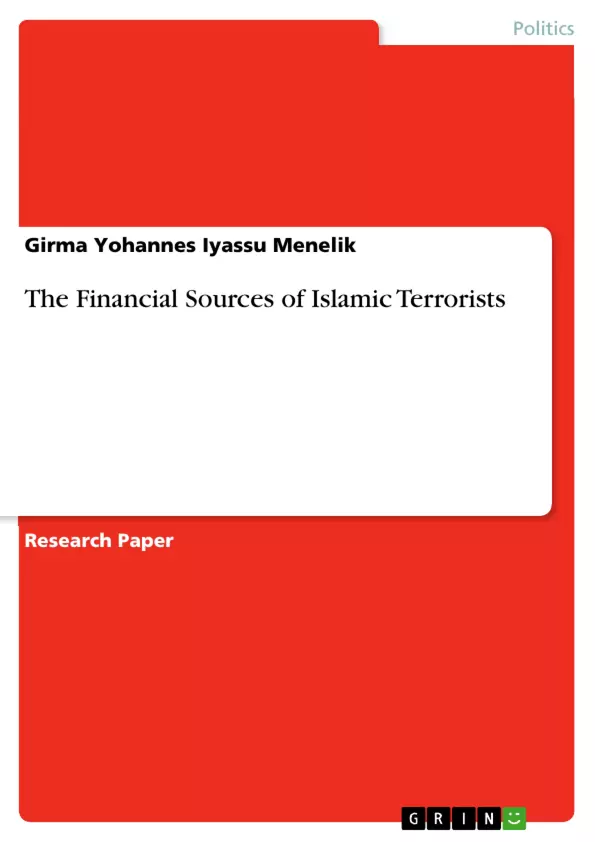This paper is not about the economics of terrorism, though economic concepts can help design strategies and analyze the behavioral side to combat terrorism. Here we discuss about the increasing financial sources and methods of their modern fundraising.
The al Qaeda terrorist network and its sources of funding seem very complicated and mysterious at large. And much of what we know may only be speculation. The CIA has estimated, for example, that it cost Al Qaeda’ some $30 million a year to sustain itself during the period preceding 9/11, but the agency is still not sure what al Qaeda needs or expends today.
What we know today is the modified money transfer system of Al-Qaeda, the way it moves funds around the globe. Before September 11, many financial institutions have helped transfer millions of dollars of al-Qaeda’s money, without any problem.
However, after greater inspection over the past transactions, other policies were created to prevent legal transmission of terrorist funds after 9/11. Today terrorists are increasingly using the informal hawala, a very historical transaction system. To transport the huge amount of cash money, diamonds and gold they use donkeys, mules and horses to transport to the very remote areas.
Inhaltsverzeichnis (Table of Contents)
- The Financial Sources of Al Qaeda
- The Al Qaeda's Financial Networks
- Bin Laden's Personal Funds and Businesses
- Al Qaeda's Financial Facilitators
- The International Islamic Relief Organization and Charities (IIRO)
- Al Qaeda Finances: From Saudi Arabia to the Continents
- The Sudan, Yemen, Philippines and Malaysia Connections
- Europe: Liechtenstein, Switzerland and Italy
- United States of America and Canada
- Taliban-Al Qaeda International Drug Business
- The New Terror Front in North-West Africa
- Future Plans of Al Qaeda-GSPC Alliance
- Global Tactics and Fundraising
- GSPC'S Growing International Network
Zielsetzung und Themenschwerpunkte (Objectives and Key Themes)
This work examines the financial resources and sponsors of Al Qaeda, providing an overview of the terrorist network's financial structures and sources of funding. The text delves into the complexities of Al Qaeda's financial networks, highlighting the evolution of its funding mechanisms and the involvement of various organizations and individuals in facilitating its activities.- Al Qaeda's Financial Networks and Funding Mechanisms
- The Role of Charities and Financial Facilitators
- Al Qaeda's International Connections and Sources of Funding
- The Impact of Al Qaeda's Financial Resources on its Operations
- The Challenges of Countering Al Qaeda's Financial Activities
Zusammenfassung der Kapitel (Chapter Summaries)
- The Financial Sources of Al Qaeda: This chapter examines the diverse financial sources that Al Qaeda relies upon, emphasizing the role of personal funds, business ventures, and the utilization of informal money transfer systems like hawala. It also highlights the impact of the 9/11 attacks on Al Qaeda's financial operations and the subsequent shift towards local fundraising strategies.
- Al Qaeda's Financial Facilitators: This chapter explores the intricate network of individuals and organizations that support Al Qaeda's financial activities. It delves into the role of charities, shell companies, and legitimate businesses in concealing and transferring funds, focusing on key figures and organizations associated with these activities. The chapter also discusses the challenges of identifying and countering these facilitators.
- Al Qaeda Finances: From Saudi Arabia to the Continents: This chapter explores the geographical reach of Al Qaeda's financial network, outlining its connections and funding sources in various regions including Sudan, Yemen, Philippines, Malaysia, Europe, and North America. It highlights the international nature of Al Qaeda's financial operations and the complex network of relationships involved in sustaining its activities.
- Taliban-Al Qaeda International Drug Business: This chapter investigates the alleged involvement of Al Qaeda and the Taliban in the international drug trade, examining its potential role as a source of revenue for the terrorist network.
- The New Terror Front in North-West Africa: This chapter explores the emerging threat of Al Qaeda's alliance with the Group for the Support of Islam and Muslims (GSPC) in North-West Africa. It delves into the group's future plans, fundraising strategies, and the expansion of its international network.
Schlüsselwörter (Keywords)
This work focuses on the financing of Al Qaeda, exploring various aspects of its financial operations, including its funding sources, networks, facilitators, and geographical reach. Key concepts explored include the use of charities, informal money transfer systems, and international connections in sustaining Al Qaeda's activities. The text also highlights the challenges of countering Al Qaeda's financial activities and the ongoing efforts of counter-intelligence and enforcement agencies.- Citar trabajo
- Professor. Dr. Girma Yohannes Iyassu Menelik (Autor), 2005, The Financial Sources of Islamic Terrorists, Múnich, GRIN Verlag, https://www.grin.com/document/135969



